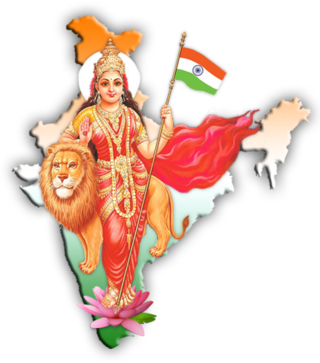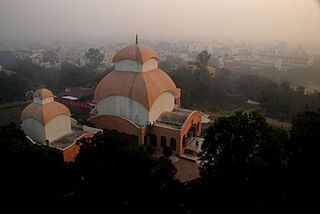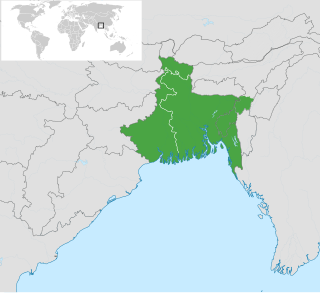Related Research Articles

Lakshmi also known as Shri, is one of the principal goddesses in Hinduism. She is the goddess of wealth, fortune, power, beauty, fertility and prosperity, and associated with Maya ("Illusion"). Along with Parvati and Saraswati, she forms the Tridevi of Hindu goddesses.

Bharat Mata is a national personification of India (Bharat) as a mother goddess. Bharat Mata is commonly depicted dressed in a red or saffron-coloured sari and holding a national flag; she sometimes stands on a lotus and is accompanied by a lion.

Vande Mātaram is a poem written in Sanskritised Bengali by Bankim Chandra Chatterjee in the 1870s. The first two verses of the poem were adopted as the National Song of India in October 1937 by the Congress.

Bankim Chandra Chattopadhyay was an Indian novelist, poet, essayist and journalist. He was the author of the 1882 Bengali language novel Anandamath, which is one of the landmarks of modern Bengali and Indian literature. He was the composer of Vande Mataram, written in highly Sanskritised Bengali, personifying India as a mother goddess and inspiring activists during the Indian Independence Movement. Chattopadhayay wrote fourteen novels and many serious, serio-comic, satirical, scientific and critical treatises in Bengali. He is known as Sahitya Samrat in Bengali.

Durga Puja, also known as Durgotsava or Sharodotsav, is an annual festival originating in the Indian subcontinent which reveres and pays homage to the Hindu goddess Durga, and is also celebrated because of Durga's victory over Mahishasura. It is particularly celebrated in the Eastern Indian states of West Bengal, Bihar, Jharkhand, eastern Uttar Pradesh, Assam, Odisha and by Hindus in Bangladesh. The festival is observed in the Indian calendar in the month of Ashvin, which corresponds to September–October in the Gregorian calendar. Durga Puja is a ten-day festival, of which the last five are of the most significance. The puja is performed in homes and public, the latter featuring a temporary stage and structural decorations. The festival is also marked by scripture recitations, performance arts, revelry, gift-giving, family visits, feasting, and public processions called a melā. Durga Puja is an important festival in the Shaktism tradition of Hinduism. Durga Puja in Kolkata has been inscribed on the intangible cultural heritage list of UNESCO in December 2021.

Jagatdhatri or Jagaddhatri is an aspect of the Hindu goddess Durga, worshipped in the Indian state of West Bengal and other states like Odisha and Jharkhand. Jagaddhatri Puja is particularly famous in Chandannagar town of Hooghly district,Krishnanagar of Nadia district and Ichhapur Nawabgunj of North 24 Parganas in West Bengal where it is celebrated as a five-day-long festival. Her worship and rituals are derived from Tantra. It is believed that her worship frees her devotees from ego and all other materialistic desires.

The Shakta pithas, Shakti pithas or Sati pithas are significant shrines and pilgrimage destinations in Shaktism, the mother goddess denomination in Hinduism. The shrines are dedicated to various forms of Adi Shakti. Various Puranas such as Srimad Devi Bhagavatam state the existence of a varying number of 51, 52, 64 and 108 Shakta pithas of which 18 are named as Astadasha Maha (major) in medieval Hindu texts.

Anushilan Samiti was an Indian fitness club, which was actually used as an underground society for anti-British revolutionaries. In the first quarter of the 20th century it supported revolutionary violence as the means for ending British rule in India. The organisation arose from a conglomeration of local youth groups and gyms (akhara) in Bengal in 1902. It had two prominent, somewhat independent, arms in East and West Bengal, Dhaka Anushilan Samiti, and the Jugantar group.

Sheetalalit. '"coolness"', also spelled as Shitala and Seetla, is a Hindu goddess venerated primarily in North India. She is regarded to be an incarnation of the goddess Parvati. She is believed to cure poxes, sores, ghouls, pustules, and diseases, and most directly linked with the disease smallpox. Sheetala is worshipped on Tuesday Saptami and Ashtami, especially after Holi during the month of Chaitra. The celebration of the goddess Sheetala on the seventh and eighth day of the Hindu month is referred to as the Sheetala Saptami and Sheetala Asthami, respectively.

Konnagar is a town and municipality of Hooghly district in West Bengal, India. A railway station connects Konnagar with the city of Howrah. The town is under the jurisdiction of the Uttarpara police station in Serampore subdivision and the Kolkata Metropolitan Development Authority (KMDA).
Amarendranath Chatterjee was an Indian independence movement activist. In charge of raising funds for the Jugantar movement, his activities largely covered revolutionary centres in Bihar, Odisha and the United Provinces.

Ramakrishna (1836–1886) was an Indian Bengali Hindu mystic. Born as he was during a social upheaval in Bengal in particular and India in general, Ramakrishna and his movement—Ramakrishna Mission—played a leading role in the modern revival of Hinduism in India, and on modern Indian history.

Sri Aurobindo was an Indian philosopher, yogi, maharishi, poet, and Indian nationalist. He was also a journalist, editing newspapers such as Bande Mataram. He joined the Indian movement for independence from British colonial rule, until 1910 was one of its influential leaders, and then became a spiritual reformer, introducing his visions on human progress and spiritual evolution.

Hinduism is the largest religious tradition in the Indian state of West Bengal with approximately 70.54% of the population identifying themselves as Hindus. The Hindus in West Bengal mostly belong to the Shakta, minority to Vaishnavite and a small community belong to Shaivite and other denominations. The vast majority of Hindus in West Bengal are Bengali Hindus numbering around 55 million and comprising 60.2% of the state population of 91.35 million (2011) but a notable section of non-Bengali Hindus also exist, particularly among Marwaris, Biharis, Odias, Gurkhas, Sindhis, Gujaratis and various tribal communities such as Koch, Santals, Munda, Mech people and particularly Adivadis numbering around 9.4 million comprising rest 10.3% of the state population.

Kali Puja, also known as Shyama Puja or Mahanisha Puja, is a festival originating from the Indian subcontinent, dedicated to the Hindu goddess Kali. It is celebrated on the new moon day of the Hindu calendar month of Ashwayuja or Kartika. The festival is especially popular in the region of West Bengal, and other places like Mithila, Jharkhand, Odisha, Assam, and Tripura, as well as the town of Titwala in Maharashtra, along with the neighbouring country of Bangladesh.

Aurobindo's political career lasted only four years, from 1906 to 1910. Though he had been active behind the scene surveying, organizing and supporting the nationalist cause, ever since his return to India, especially during his excursions to Bengal. This period of his activity from 1906-1910 saw a complete transformation of India's political scene. Before Aurobindo began publishing his views, the Congress was an annual debating society whose rare victories had been instances of the empire taking a favourable view to its petitions. By the time Aurobindo left the field, the ideal of political independence had been firmly ingrained into the minds of people, and nineteen years later, it became the official raison d'être of the Congress.

Chittaranjan Park Kali Mandir is a temple complex and Bengali community cultural center in Chittaranjan Park in New Delhi, India. Built on a small hill, it started as a Shiv temple in 1973, which still stands within the complex, the larger shrines dedicated to goddess Kali, Shiva, and Radhakrishna were added in 1984. Over the years it has remained an important centre of convergence of local Bengali community during annual Durga Puja festivities.

Baṅgamātā, Bangla Maa, Mother Bengal or simply বাংলা/ Bangla, is a personification of Bengal created during the Bengali Renaissance and later adopted by the Bengali nationalists. In Bangladeshi Bengali and Indian Bengali poetry, literature, cultural and patriotic song, she has become a symbol of Bangladesh and India's West Bengal & Tripura and considered as a personification of the People's Republic of Bangladesh. The Mother Bengal represents not only biological motherness but its attributed characteristics as well – protection, never ending love, consolation, care, the beginning and the end of life.
The history of the Anushilan Samiti stretches from its beginning in 1902 to 1930. The Samiti began in the first decade of the 20th century in Calcutta as conglomeration of local youth groups and gyms(Akhra). However, its focus was both physical education and proposed moral development of its members. From its inception it sought to promote what it perceived as Indian values and to focus on Indian sports e.g. Lathi and Sword play. It also encouraged its members to study Indian history as well as those of European liberalism including the French Revolution, Russian Nihilism and Italian unification. Soon after its inception it became a radical organisation that sought to end British Raj in India through revolutionary violence. After World War I, it declined steadily as its members identified closely with leftist ideologies and with the Indian National Congress. It briefly rose to prominence in the late second and third decade, being involved in some notable incidents in Calcutta, Chittagong and in the United Provinces. The samiti dissolved into the Revolutionary Socialist Party in 1930.

The Mahakal Temple or Mahakal Mandir. Translation: The master of Kaal[time]) is a sacred Hindu temple located in Darjeeling, West Bengal, India, dedicated to the Hindu god Shiva, the third god in the Hindu triumvirate. The temple was built in 1782 by Lama Dorjey Rinzing and is perched atop the Observatory Hill and is an amalgamation of Hindu and Buddhist religions. It is a religious site where both religions coexist harmoniously.
References
- ↑ Narangoa & Cribb 2003 , p. 32
- 1 2 3 Hanimaki & Blumenau 2013 , p. 158
- ↑ McDermott 2011 , p. 59
- ↑ "Bhawani Mandir by Aurobindo Ghose". INDIAN CULTURE. Retrieved 29 April 2023.